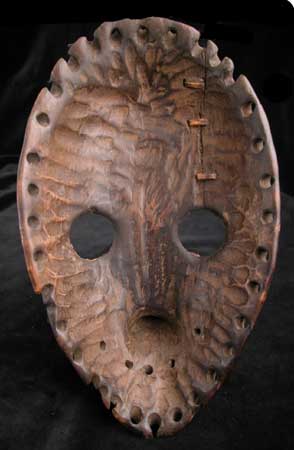Dan Gunyeya/Gunyege (Runner) Mask, 1900 CE - 1930 CE
Wood
9.5
PF.6207 (LSO)
Further images
This outstanding piece is a Dan “gunyege” (runner) mask, made by the Dan group. It is a remarkable example of its type. It has a very tall, broad apex, widening...
This outstanding piece is a Dan “gunyege” (runner) mask, made by the Dan group. It is a remarkable example of its type. It has a very tall, broad apex, widening to the cheekbones and narrowing to a pointed chin. The forehead is high and domed, running down to wide, circular eyes under sharp brows, a broad, flat nose and a prominent mouth. The eyes and the upper lip were once adorned with white inlay and hair, respectively, of which some traces remain. The patination is superb, and further evidence for long usage can be seen in the worn holes around the perimeter (used to attach a costume), the internal polish, and the indigenous repair to the right side.
The Dan are a farming tribe, settled in the semi- wooded areas of Liberia and the Ivory Coast. While beholden to agriculture, much of their mythology and social structure is based upon the forest and its fiercer creatures – the Leopard Society is the main organ of social control. For example, initiates spend up to four months alone in the forest before they are permitted to enter maturity.
They are one of the most prolific masking groups in Africa, as there was scarcely a social function that did not have its own mask prior to the 1960s. For example, there are masks for fire-watching (= fire warden), adjudicators, warriors, debt collectors, social delinquents and warriors, and others for enlisting workers to clear paths, to catch runaway wives, to snatch feast food to serve to children and even for spying. Small “passport” masks were kept as talismans of good luck, and also served as markers of authority and ambassadorial functions. Masks were inherited through lineages, kept on altars and endowed with libations; they achieve their dark colour through immersion in black mud sacred materials. Some retain traces of what are presumed to be the remains of magical substances.
Function is not always easy to ascertain, paradoxically, as the masks were usually associated with costumes that have not survived, and with particular occasions, dances or people. In the current case, however, function is very clear as it is a near-perfect example of the genre. Named “gunyege”, these masks were worn by a sprinter and pursued by unmasked initiates. Once caught, he had to surrender the mask and the capturer would wear it and be pursued. They were somewhat vigorous pursuits, designed to train the men to fight.
These masks are the most elegant and impressive of the Dan repertoire. This is a superb example of a rare and beautiful form.
The Dan are a farming tribe, settled in the semi- wooded areas of Liberia and the Ivory Coast. While beholden to agriculture, much of their mythology and social structure is based upon the forest and its fiercer creatures – the Leopard Society is the main organ of social control. For example, initiates spend up to four months alone in the forest before they are permitted to enter maturity.
They are one of the most prolific masking groups in Africa, as there was scarcely a social function that did not have its own mask prior to the 1960s. For example, there are masks for fire-watching (= fire warden), adjudicators, warriors, debt collectors, social delinquents and warriors, and others for enlisting workers to clear paths, to catch runaway wives, to snatch feast food to serve to children and even for spying. Small “passport” masks were kept as talismans of good luck, and also served as markers of authority and ambassadorial functions. Masks were inherited through lineages, kept on altars and endowed with libations; they achieve their dark colour through immersion in black mud sacred materials. Some retain traces of what are presumed to be the remains of magical substances.
Function is not always easy to ascertain, paradoxically, as the masks were usually associated with costumes that have not survived, and with particular occasions, dances or people. In the current case, however, function is very clear as it is a near-perfect example of the genre. Named “gunyege”, these masks were worn by a sprinter and pursued by unmasked initiates. Once caught, he had to surrender the mask and the capturer would wear it and be pursued. They were somewhat vigorous pursuits, designed to train the men to fight.
These masks are the most elegant and impressive of the Dan repertoire. This is a superb example of a rare and beautiful form.









